The AMD Kabini Review: A4-5000 APU Tested
by Jarred Walton on May 23, 2013 12:00 AM ESTKabini Gaming and Battery Life
We've covered the general performance and some synthetic graphics tests. What about actual games? Well, here’s what our (admittedly punishing) 2013 gaming suite looks like on Kabini. These are the "Value" results, as the "Mainstream" and "Enthusiast" settings are unplayable on anything without a dGPU (though those results are available in Mobile Bench if you're interested).
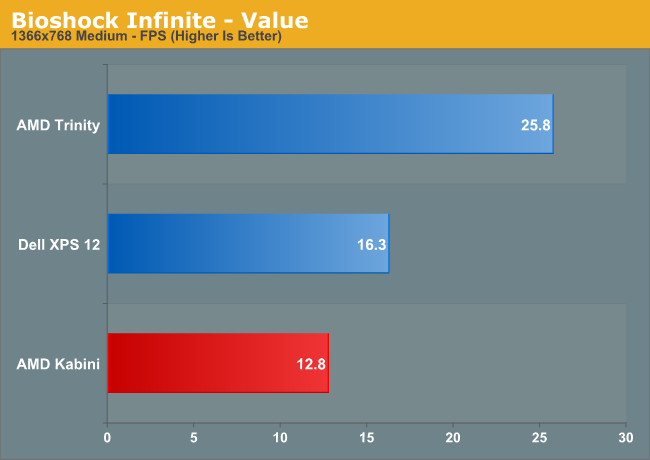

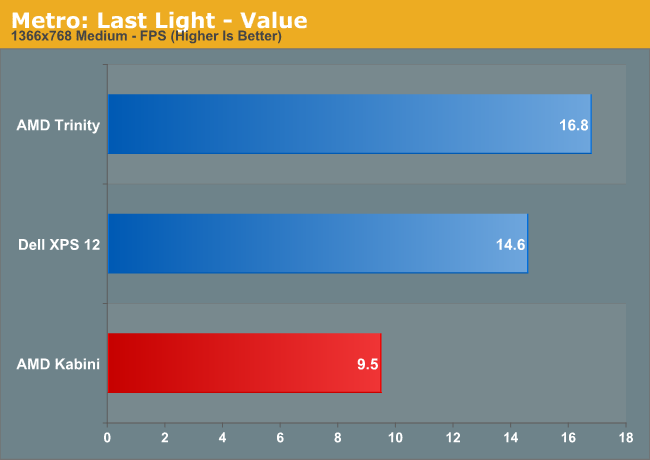
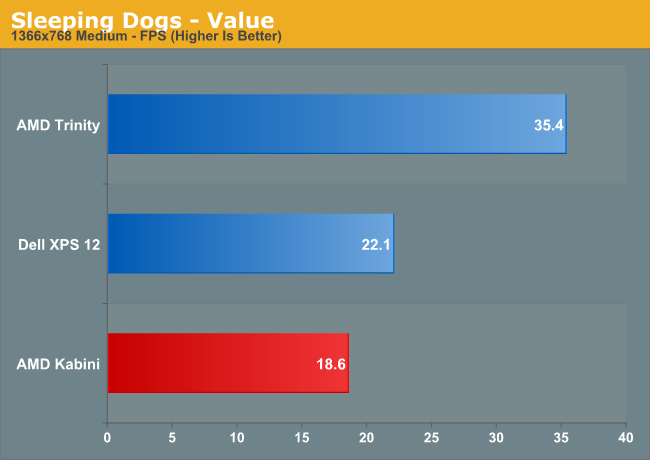
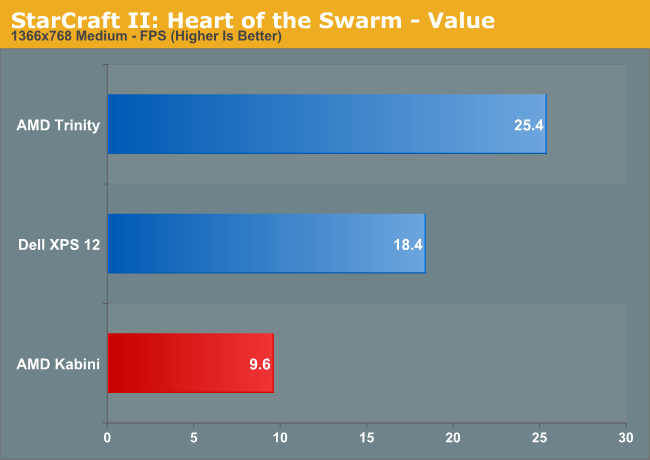
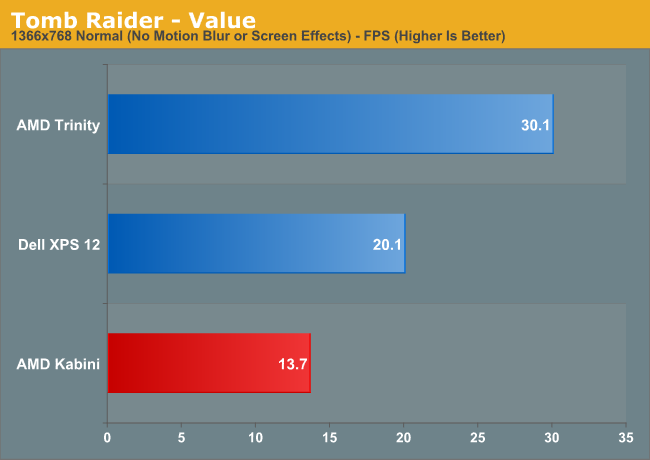
The short summary is that not a single game manages to crest the 30FPS mark, and I even ran additional tests at the minimum quality settings (at 1366x768) to see if I could improve the results. Sadly, I couldn’t, at least not enough to make the games playable; the best I managed was around 25 FPS in Bioshock, Skyrim, and Tomb Raider at minimum detail, and most titles remained in the sub-20 FPS range. Titles that tend to be more taxing on the CPU side of things like StarCraft II are even worse, with frame rates in StarCraft II being half of what IVB ULV gets at our Value (medium quality minus antialiasing) preset.
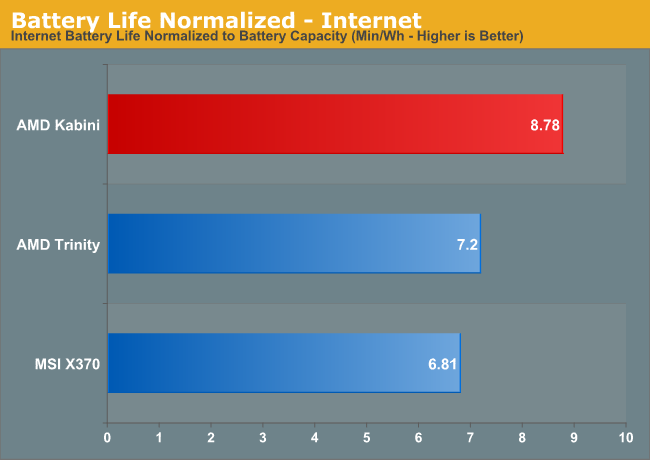
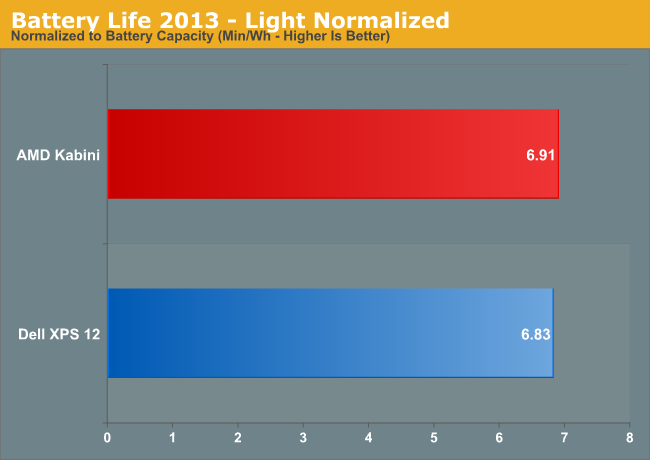
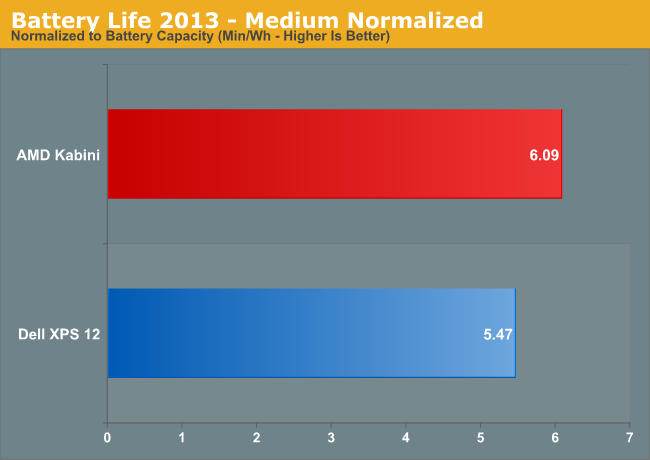
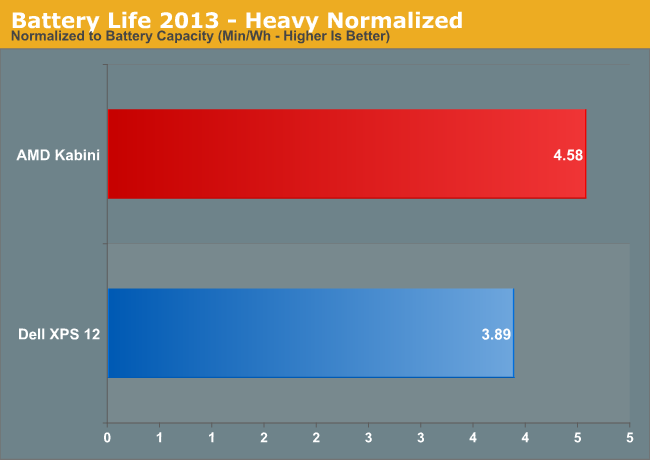
The good news is that not only is Kabini noticeably faster than Brazos, but it’s also mighty frugal when it comes to power use. We don’t have any Brazos laptops handy, so we had to use our older Internet battery life test as a comparison point (100 nits instead of 200 nits); in that test, Kabini topped 6.5 hours with a 45Wh battery. The MSI X370 we’re using as a comparison point did last a bit longer, but it also has a 64Wh battery. In terms of normalized power use, the Kabini laptop ends up being 29% more efficient, and that’s with a 14” AHVA 1080p panel going up against a 13.3” TN 768p display. We’re not quite able to compare apples to apples, but Kabini definitely looks like a good improvement over Brazos in power use.
The power story is even better when we look at ULV Ivy Bridge and standard Trinity APUs. Using our new battery life tests, which push the hardware a lot harder than our previous tests, Kabini delivers normalized battery life that’s at least equal to IVB ULV (our “Light” test), and in the more taxing Medium and Heavy tests Kabini beats ULV by 11% and 18%, respectively. Of course the IVB ULV system is still faster, and it’s also likely to cost twice what we expect Kabini laptops to sell for, but lower cost Celeron and Pentium ULV parts shouldn't be all that different. Also of note is that we don’t know yet how Haswell will fare in these same tests, but that’s an area Intel seems to be focusing on for their next CPU; that’s a story for next month….










130 Comments
View All Comments
georgec84 - Thursday, May 23, 2013 - link
These chis look great! I hope it can provide AMD with a small spark. They certainly seem to be looking up compared to 2 years ago.Nintendo Maniac 64 - Thursday, May 23, 2013 - link
I think it would have been interesting if Anand tested the CPU against some older mid-range to high-end CPUs. From my own assessments it looks like Jaguar has slightly better IPC than K8 and is overall comparable to the original Phenom (though obviously without the huge power consumption).JDG1980 - Thursday, May 23, 2013 - link
I really want to see a comprehensive rundown of single-threaded tests with constant clock rate. We have a rough idea of which architectures have better IPC, but I'd like to see some hard numbers.Streetwind - Thursday, May 23, 2013 - link
This is the first real step forard for AMD I've seen in nearly a decade... everything else were minor clock speed bumps, experimental architectures that ended up being slower clock-for-clock than the old ones, big iGPUs and shuffling around its product stack to target a changing market with the same technology.The performance advantage Intel has accumulated over the years means that AMD can still only really compete via price, but Kabini is finally the kind of product that attempts to narrow the gap with the competition again. Please AMD, more of this! Maybe in one or two years we the consumers will have a real choice in the x86 market again if you keep it up.
KaarlisK - Thursday, May 23, 2013 - link
Regarding memory performance: as I understand it, Kabini supports two DIMMs, but only single-channel.darkich - Thursday, May 23, 2013 - link
Why are you always comparing that dual core ARM chip?Why not Octa chip?(like, the best currently available ARM chip)
And why always avoid using Geekbench, but instead use a heavily software dependant tests?
This always seems to be case when dealing with ARM on this site.
Really, it looks like a deliberate undermining of the architecture, in my mind.
kyuu - Thursday, May 23, 2013 - link
One: the "octa chip" is really quad-core.Two: Geekbench is not a great benchmark utility, especially when comparing cross-platform.
Three: Attributing an anti-ARM agenda to this website is pretty freakin' silly.
darkich - Thursday, May 23, 2013 - link
One: the chip has 4+4 independently operated core clusters.Operating at low power cores makes for a very advanced solution, compared to big cores revving down for a certain task.
Besides, what does your remark have to do with what I said?
My point is, Octa is a FAR more capable ARM chip than the one used in this comparison.. yet it doesn't cost more, and consumes up to 70% less power.
Two: as opposed to what? Comparing Chrome for Android with Chrome for Windows?
Geekbench is not perfect, but it is the best you can try when comparing across platforms.
It is the ONLY credible comparison of pure processing abilities in this case.
Three: answer the first two then. What am I missing here?
darkich - Thursday, May 23, 2013 - link
Correction..I meant two modules (core clusters), with 4 cores each, of courseWilco1 - Thursday, May 23, 2013 - link
And those 2x4 cores can run simulataneously with the right software, hence the name Octa.I agree with darkich that Anand always appears to show ARM in the worst light, first by only showing JavaScript browser tests rather than native code benchmarks, and second by insisting on the Chrome browser rather than the stock or fastest available browser. For example Geekbench shows that Exynos Octa easily beats Bobcat at the same frequency:
http://browser.primatelabs.com/geekbench2/compare/...
This means Jaguar will get very close to A15 - until Cortex-A57 is released of course.